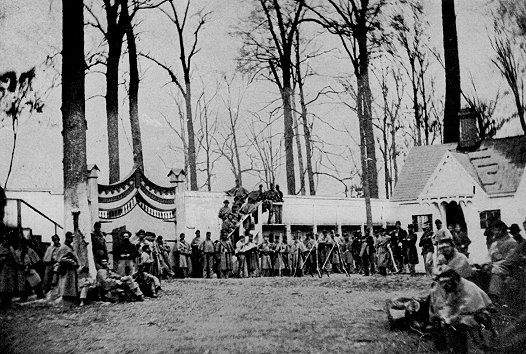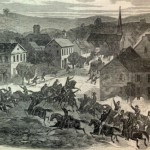Early one warm August morning, before the sun rose, nineteen-year-old Louis Bir and two of his friends stood at the Market House in New Albany, Indiana. They had walked ten miles in the dark from their homes near Floyds Knobs to enlist in an Indiana regiment and fight for the Union in the Civil War.
Bir and his friends were probably typical of many young men who dreamed of getting out of their small towns and away from their family farms. Bir was the fourth of seven children, living with his widowed mother. He had begun to work at the age of seven “from daylight until Dark” to support his family, and had only a few years of schooling and that for three months out of each year.
As soon as Governor Oliver Morton issued the first call for volunteers, Bir was “very anxious to Inlist” but for several months remained at home at his mother’s request. Finally, he could wait no longer, and with his friends William Atkins and Val Hellwic, he headed into town to enlist.
The three young men easily found a recruiter, signed their names, and then to celebrate that they “were men then” they went to “take a Drink & then another and So on.” After returning home for the weekend, they joined their new company and arrived at their first camp at the Floyd County fairgrounds. On their short trip, the recruits were hailed by people along the road with “a Rousing & Hartily greeting” that made Bir feel “great Patriotism.”
Young Bir, from a large and poor family, was even impressed with camp food, which offered brown sugar for his coffee. Using it “freely” at first, Bir made himself sick with the new luxury.
The flush of the first few weeks wore off as Bir and his fellow soldiers left their training and went to war. Bir would serve until he was mustered out in 1865. He was part of the siege of Vicksburg and fought as Union troops took the city of Nashville and captured Fort Morgan, Alabama. He marched in all kinds of weather; ate hardtack and drank camp coffee (without sugar); and watched many of his comrades die.
Val Hellwic also survived the war; Williams Atkins died at the Battle of Guntown on June 10, 1864.
After the war, Louis Bir returned to New Albany, Indiana, where he married and became a businessman. While he and his wife Sophia raised a family, Louis made his way up the economic ladder of postbellum society. By 1872, he was the proprietor of a city bakery; a decade later he owned a sawmill which became Bir Lumber Company; and eventually he invested some of his capital in real estate and a glass factory. He was an active member of the Grand Army of the Republic and attended one of its national encampments at Washington, D.C., in 1892.
And at some point during these years, he sat down with a stack of blank business forms and wrote a memoir of his years as a soldier in the great conflict, a “Remenecense” of his life in the Union Army which he signed simply “Yours Louis Bir Sargent Co K 93 Ind.”
Source: George P. Clark, “A Hoosier Civil War Veteran and His Memoir of Service in the Western Theater” and Louis Bir, “Remenecense of My Army Life,” Indiana Magazine of History 101 (March 2005).
A Moment of Indiana History is a production of WFIU Public Radio in partnership with the Indiana Public Broadcasting Stations. Research support comes from Indiana Magazine of History published by the Indiana University Department of History.























